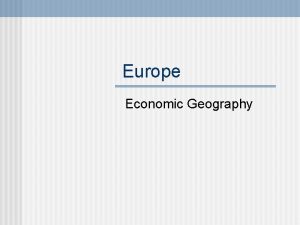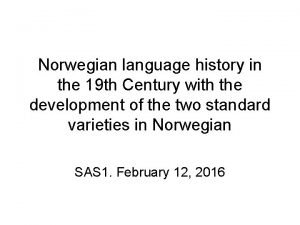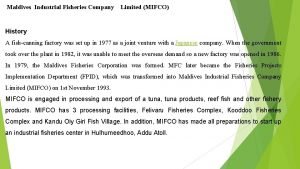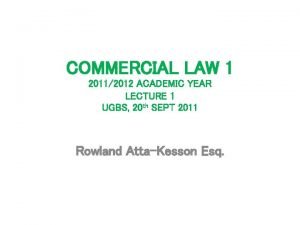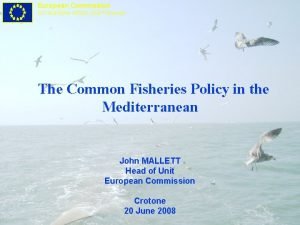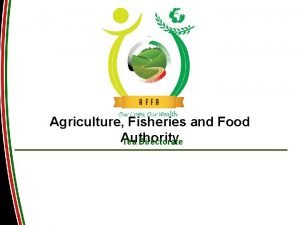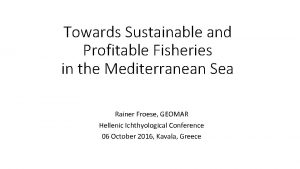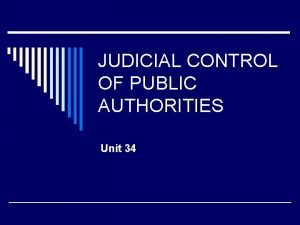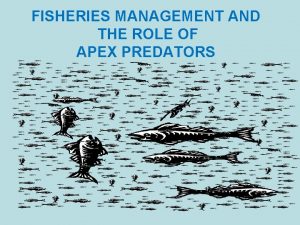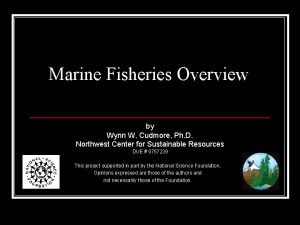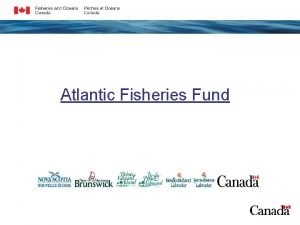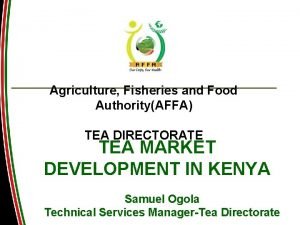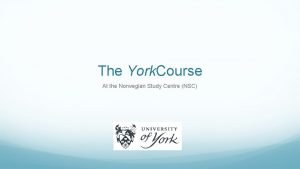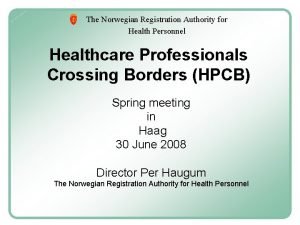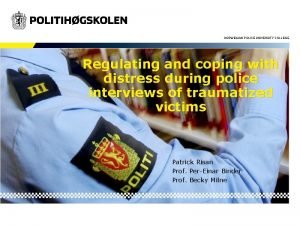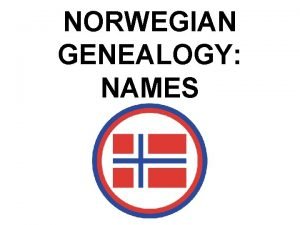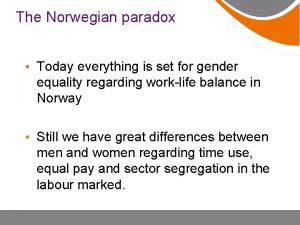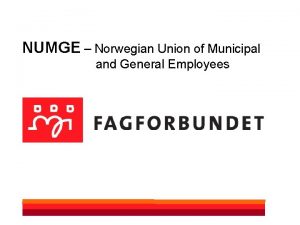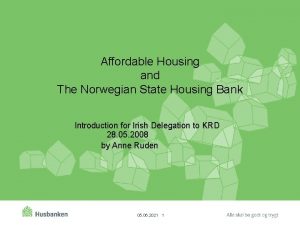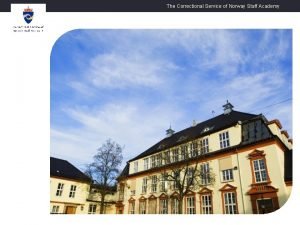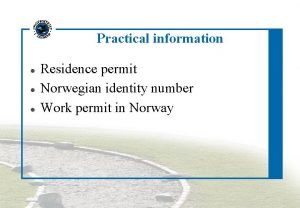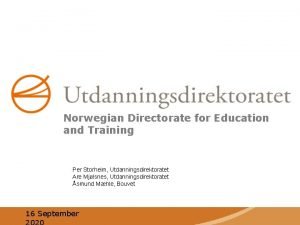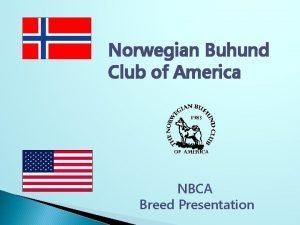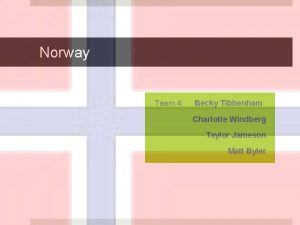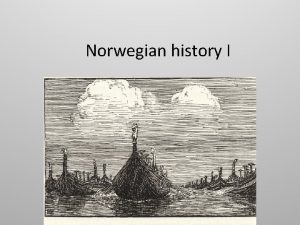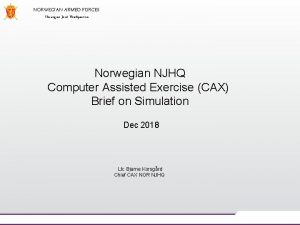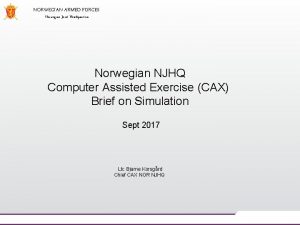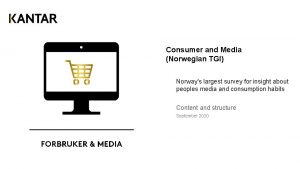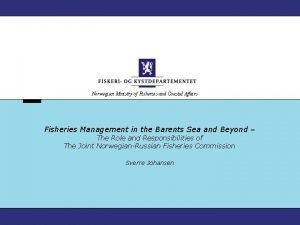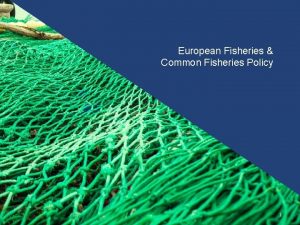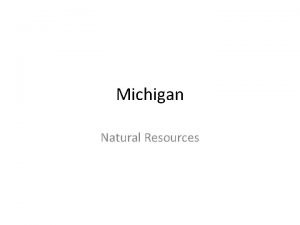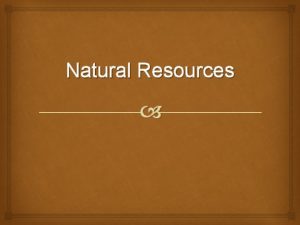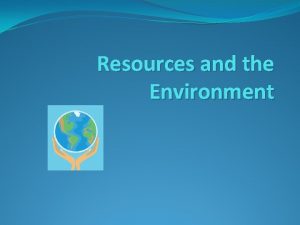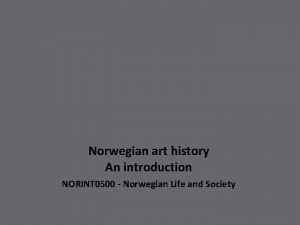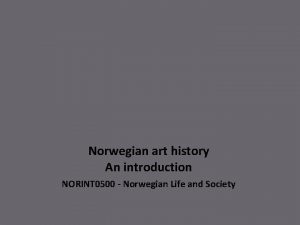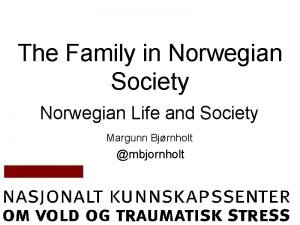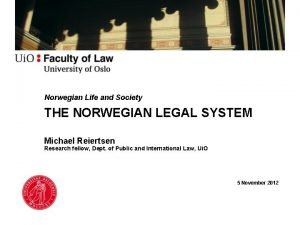Norwegian history I Europe Norways natural resources Fisheries

















































- Slides: 49

Norwegian history I

Europe

Norway’s natural resources • • • Fisheries Forestry Mining industries Shipping Today: oil and gas Tomorrow?

Future challenges • Reduce global warming • Industrial innovation • Development of green energies to replace oil and gas

Europe

Prehistoric Norway 10 000 BC 4000 BC 1800 BC 500 BC Migration into Scandinavia Agriculture Bronze Iron

200 AC: Runes • Carved into stone • Commemoration of persons and events • Not a written culture in Norway until 11 th century


500 AC: Seagoing ships • Settlements mainly along the coast • Ships used for fishing, transport and trade • ”Norway”- ”Norwegen”- ”Norvège” = The way north • Maritime traditions essensial in Norwegian culture

The Oseberg ship


300 -500 AC: Migration period • Tribal peoples from the east migrated into western Europe and Scandinavia • Regional kingdoms • Clan society

Pre-state institutions • Ting - Regional political assemblies • Law - Regional lawcodes, oral tradition • Religion - Polytheistic, non-dogmatic. Emphasizing life on earth


Pre-state institutions • Ting - Regional political assemblies • Law - Regional lawcodes, oral tradition • Religion - Polytheistic, non-dogmatic. Emphasizing life on earth

The Viking Age • Armed warriors from Scandinavia attack settlements abroad • Lindisfarne 793 • Viking colonies: North Sea- and Baltic region, Russian inland, The British Isles, Normandy, Iceland, Greenland, New Foundland.

Viking campaigns and settlements


What caused the expansions? • Good naval skills and equipment • High stakes and low risk: Weak opposition abroad • Military conflicts at home drove people away from the country • Overpopulation?

Viking trade • Commercial excange along the travelling routes • Natural products and slaves against luxury items and silver • Urban settlements/market places: Dublin, York, Dorestad, Hedeby, Skiringssal, Birka, Novgorod • Many viking towns disappeared with viking trade

Viking age legacy • • Political unification National kingdom: Harald Fairhair 872 Religious reform Missionary kings: Håkon the Good, Olav Trygvason, Olav the Holy (St. Olav)

St. Olav, the reforming figure king 1015 -1030 • Viking and Christian martyr • Legend and saint • Olav’s defeat the turning point: Monarchy and church generally accepted as institutions after Olav


1030 -1130: Consolidation of Norwegian kingdom • Strong military rulers • Western colonies brought under royal administration • Harald Hardruler • Magnus Barefoot • Sigurd Crusader

1130 -1240: Civil wars • Rivaling parties and kings fight over hegemony • The problem of royal succession: a system based on inheritance and popular election

Authority contest between Monarchy and Church • 1152: The Norwegian church underlain Rome • Church claim political independence: pope versus German emperor • In Norway: Church party versus rojalist party, archbishop Eystein versus king Sverre • King Sverre excommunicated 1194 • The medieval church: wealthy and powerful


Monarch versus archbishop Sverre Eystein

Culmination of the medieval kingdom • Monarchy extended its power and administration: Royal ombudsmen • Foreign policy: Focus on Norwegian North Sea Empire under king Håkonsson • King Magnus Lawmender: Diplomacy abroad. Administrative reforms at home • National lawcode 1274. • Settlement between monarchy and the church 1277 • King Håkon 5 th: Great building activity. Oslo capital

Social conditions • • Population growth Peasants: from freeholders to tenant farmers The free position of Norwegian peasants The old clan aristocracy displaced by a new elite of royal ombudsmen

Chivalric culture • Feudal forms adapted into Norwegian social system: barons and knights • Smaller social differences than abroad • Chivalric ideals • Fine arts and literature • Snorre Sturlasson: Heimskringla • The impact of christianity: a more humane society

Snorre Sturlasson

Black death and economic crisis • 1349: Nearly half the population killed by plague • Many farms left vacant • Price fall on agricultural products • Hard times for rural aristocracy • Better times for subsistence farmers



From national independence to subordination under Denmark • Personal union with Sweden. • Outside threats cause political unrest in Scandinavia • The Hanseatic Leaugue • The Kalmar Union • Union with Denmark • The fief system: Danish nobility take over the administration in Norway • Archbishop defender of national independence • 1537: Reformation. Full national subordination




Economic setback 1350 -1500 • Due to falling prices in agriculture and population loss • The big landowners got poorer • The climate got colder • Shift from corn production to livestock farming • Better times for the farmers

Economic growth after 1500 • • Hansa monopoly broken Timber trade/sawmill industry Shipping Mining industries

Population development Year population 1300 450 000 1355 225 000 1660 440 000 1801 883 553

From 1537: Danish rule • Lutheranism replace catholicism. The church underlain monarchy. All church property transferred to the crown. • Danification • Peasant freedom – thanks to geographical conditions • Norwegian mindset – explains ”no to EU”?

The wars with Sweden • • • The Seven Years War 1563 -70 The Kalmar War 1611 -13 The Hannibal Feud 1643 -45 The Revenge War 1657 -60 The Great Nordic War 1700 -21

Royal autocracy 1660 -1814 • All power to the king. The aristocracy deprived of privileges • Administrative reform: Fief system replaced by professional royal bureaucracy. • ”The twin kingdoms”: Denmark and Norway = one state


Danish cultural influence • • The Bible translated to Danish was the literary language All higher education in Danish language for the upper classes, Norwegian for the common people


Danish cultural influence • • The Bible translated to Danish was the literary language All higher education in Danish language for the upper classes, Norwegian for the common people
 Natural resources in northern europe
Natural resources in northern europe Norwegian language history
Norwegian language history Mifco logo
Mifco logo Buaful v construction pioneer
Buaful v construction pioneer Certified fisheries professional
Certified fisheries professional Southeast fisheries science center
Southeast fisheries science center Split institute of oceanography and fisheries
Split institute of oceanography and fisheries Small-scale fisheries
Small-scale fisheries Dg fisheries
Dg fisheries Agriculture fisheries and food authority
Agriculture fisheries and food authority Northwest fisheries
Northwest fisheries Handling and transportation of fish
Handling and transportation of fish Institute of oceanography and fisheries
Institute of oceanography and fisheries Ocean fisheries
Ocean fisheries Pearson prentice hall
Pearson prentice hall Ocean fisheries
Ocean fisheries Alaska fisheries development foundation
Alaska fisheries development foundation General fisheries commission for the mediterranean
General fisheries commission for the mediterranean Nmfs org chart
Nmfs org chart Ministry of food agriculture and fisheries denmark
Ministry of food agriculture and fisheries denmark Rules of natural justice
Rules of natural justice Boat security system
Boat security system Apex fisheries
Apex fisheries Fisheries management
Fisheries management Factap
Factap Tea directorate
Tea directorate Chra europe employment
Chra europe employment What is transformed resources
What is transformed resources Example of fixed resources
Example of fixed resources Renewable resources vs nonrenewable resources
Renewable resources vs nonrenewable resources Student accommodation university of york
Student accommodation university of york Norwegian registration authority for health personnel
Norwegian registration authority for health personnel Norwegian police university college
Norwegian police university college Norwegian naming conventions
Norwegian naming conventions Occluded front cross section
Occluded front cross section Norwegian paradox
Norwegian paradox Norwegian union of municipal and general employees
Norwegian union of municipal and general employees Norwegian defence university college
Norwegian defence university college Norwegian cyclone model
Norwegian cyclone model Norwegian state housing bank
Norwegian state housing bank University college of norwegian correctional service
University college of norwegian correctional service Ligningskontoret
Ligningskontoret Frigate
Frigate Norwegian school of management
Norwegian school of management Norwegian museum of science and technology
Norwegian museum of science and technology Norwegian directorate for education and training
Norwegian directorate for education and training Norwegian buhund club of america
Norwegian buhund club of america Royal norwegian consulate
Royal norwegian consulate Nina trondheim
Nina trondheim Norwegian language
Norwegian language
